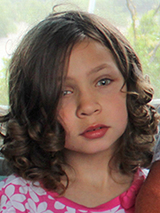Bilateral Nephrectomies for Wilms Tumors: Raritan’s Story
Bilateral Nephrectomies for Wilms Tumors: Raritan’s Story
At age 7, Raritan was diagnosed with bilateral Wilms' tumor — cancerous tumors in both of her kidneys. After starting chemotherapy, her family transferred her care to Children's Hospital of Philadelphia (CHOP), where team members from the Division of Oncology, the Division of Urology and the Department of Radiology collaborated to successfully surgically remove the tumors while maintaining as much kidney function as possible.

Raritan was born with irregularly shaped pupils, affecting her retina and causing visual impairment. In most cases, the condition, called coloboma, has no known cause, but is sometimes linked to certain genetic syndromes. Raritan’s genetic tests did not determine a cause and cleared her of the known related syndromes. As an infant she was discovered to be allergic to protein and experienced failure to thrive, and was seen by a cardiologist, a neurologist and a gastroenterologist. By age 2 she was “pretty healthy,” says her mother, Anne.
When she was 7, she began complaining that her stomach hurt. At a local New Jersey hospital, she was diagnosed with tumors in both of her kidneys and began a planned 12-week course of chemotherapy to be followed by surgery to remove the tumors.
When the doctors in New Jersey suggested performing the surgery after only six weeks of chemotherapy, the family was plunged into doubts. “We had a meeting with the surgeon,” says Anne. “It was the scariest thing ever. We didn’t know if this was where she should be.”
All along, her family had been considering getting a second opinion, and now they quickly acted on that idea. They contacted Children's Hospital of Philadelphia (CHOP).
Teaming up to create a plan
At CHOP, Raritan was seen by pediatric oncologist Frank M. Balis, MD, who had discussed the case with pediatric urologist and surgeon Thomas F. Kolon, MD. “Dr. Balis was extremely calm and explained everything clearly,” says Anne. “He said the crux is the surgery. When we came in, he’d already talked to the surgeon. He came with a plan in place.”
Second Opinions
“Bilateral surgery is tricky,” explains Balis. “When there’s a tumor on just one side, we take the whole kidney out. When there are tumors on both sides, we try to do a resection of the tumors from the kidneys and leave as much of the normal organ behind, which is a specialized technique. We recommended completing 12 weeks of chemotherapy to shrink the tumors before surgery.”
The family was reassured by what they heard. “I was more comfortable waiting until the 12 weeks were completed,” says Anne.
Because Raritan had tumors in both her kidneys that seemed to develop independently of each other, a genetic cause was suspected — something that might also be linked to her coloboma. She was seen by team members at CHOP’s Cancer Predisposition Program. Genetic testing was performed but, as with her tests as an infant, no genetic mutation was found that would cause her visual condition or the cancer.
Using 3D models to create a roadmap for surgery
To save Raritan from undergoing two rounds of anesthesia for two surgeries, Kolon planned to remove both tumors during one procedure. Getting the entire tumor out helps prevent the cancer from coming back, but the goal is to also spare as much healthy organ as possible. Using the two-dimensional MRI images of her kidney, the Department of Radiology created 3D printed models of Raritan’s kidneys so Kolon could visualize the condition of the tumors and their proximity to the arteries supplying blood to the kidneys.
“The 3D models gave us a roadmap,” says Kolon. With a 3D model, he can hold it and examine it from different viewpoints to help make a plan in advance. “The 3D models were pretty awesome,” says Anne.
How 3D Models Help
During the surgery, removing the first tumor went smoothly, allowing Kolon to successfully perform the second procedure. “After the surgery, there was a lot of communication,” says Anne. “You can tell CHOP is used to working in teams. The first few days after the surgery were pretty rough for Raritan, but seven days later she was back in school.”
“This is major surgery on both sides,” notes Kolon. “She did remarkably well.”
For the next 13 weeks, she underwent outpatient chemotherapy every three weeks at CHOP. Now a year later, 9-year-old Raritan is doing great, with Kolon and Balis deeming her risk of recurrence low, and her kidney function is normal. “It all went so smoothly at CHOP,” says Anne. “Plus, the spaces are so nice, and she loves the garden. Raritan really likes going there!”